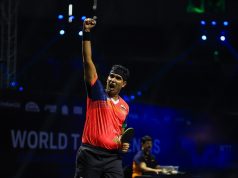In our series ‘World Champion Born On This Date,’ we will see the life of the reigning world champion, Ding Liren, and his journey to the crown today.
Ding Liren was born on 24 October 1992 in Zhejiang, to Ye Xiaoping and Ding Wenjun. Young Liren started learning Chess when he was four and surprised the Chinese Chess fraternity with his extraordinary skills.
In 2019, when he was 17, Liren became an International Grandmaster. He became China’s highest-rated Chess player in history and also became the Chinese Chess Champion thrice.
Ding Liren is the first Chinese player ever to play in a Candidates Tournament. With a Blitz rating of 2875 Elo points, Ding became the highest-rated Blitz player in the world in the same rating list. In July 2023, Ding became the No. 1 ranked Rapid player, with a rating of 2830.
Ding was undefeated in Classical Chess from August 2017 to November 2018, recording 29 victories and 71 draws. This 100-game unbeaten streak was the longest in top-level chess history until Magnus Carlsen broke it in 2019.
Ding qualified for the World Chess Championship Match 2023 after finishing runner-up in the Candidates Tournament in 2022. Incidentally, Magnus Carlsen refused to defend his title. Ding Liren won the World Championship match in April 2023 by defeating Ian Nepomniachtchi in Rapid Tiebreaks after their classical Chess match ended in a draw with a 7-7 result.
After winning the World Chess Crown, Ding has not been very consistent in his results. He refrained from playing any tournament for several months and that affected his form.
Ding will defend his Crown in the World Championship Match against the Challenger, D. Gukesh, scheduled to be held in Singapore between 25th November and 15th December 2024.
Today we shall see an important game from the World Chess Championship Match 2023 between Ding Liren and Ian Nepomniachtchi. The championship saw a lot of one-sided victories by both players, keeping the Chess world guessing about who would emerge as the new Champion.
In the following game, the champion demonstrated not only great tactical skills and accuracy but also showed the depth of his strategic understanding in some specific positions.
Ding Liren (2788) vs Ian Nepomniachtchi (2795) [D02]
World Chess Championship (6.1), 16.04.2023
1.d4 Nf6 2.Nf3 d5 3.Bf4 c5 4.e3 Nc6 5.Nbd2 cxd4! 6.exd4 Bf5 7.c3 e6
We have now reached the ‘Reversed Carlsbad Pawn Structure’. The Carlsbad Pawn Structure, which usually occurs from Queen’s Gambit Declined, is considered to be a strong point of the Russians as the greatest contribution to the strategy of this Pawn structure has been the work of Botvinnik, Karpov& Kasparov. However, Ding had done his homework very well as we will see soon.
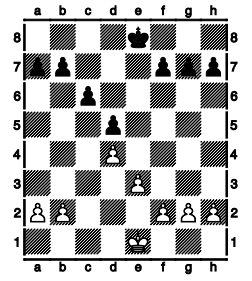
Carlsbad Pawn Structure
This Pawn Structure usually comes in Queen’s Gambit Declined.
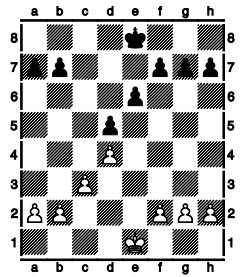
Carlsbad Reversed Pawn Structure
This Pawn Structure usually comes in Caro-Kann Defence.
Let us come back to the game. There followed 8.Bb5!?
Ding refrains from the most popular continuation 8.Qb3 and chooses a comparatively less popular move but with the specific idea of putting pressure along ‘a4–e8’ diagonal as the Black Queen Bishop is ‘out of Pawn chain’ & therefore unable to guard the ‘c6’ point.
8…Bd6?!
This natural reply is sound but it might have been more accurate to discourage White Knight from coming to ‘e5’ by ‘over-defending’ the square with8…Nd7!
9.Bxd6
9.Bxc6+ bxc6 10.Bxd6 Qxd6 11.b4 is a possibility as well but Black should equalise after 11…Bg4
9…Qxd6 10.0–0 0–0 11.Re1 h6
11…a6! , forcing White to reveal his cards immediately, is more sensible.
12.Ne5!?N
A theoretical novelty. It is also possible to place the Knight on ‘e5’ after establishing a Pawn at ‘a5’. For example,12.a4 Rfc8 13.a5 a6 (13…Qc714.a6) 14.Bxc6, Qxc6 15.Ne5 etc.
12…Ne7 13.a4 a6?!
A typical strategic error in Carlsbad Pawn structure, usually not expected from a strong Russian Grandmaster. This committal move allows White to get an outpost at ‘c5’ for his Knight. Better was13…Qb6 14.Qb3 a5!with equality.
14.Bf1 Nd7?!
14…Qc7 was safer. It was possible to guard the ‘c5’ square with 14…a5 but it would have resulted in weakening of ‘b5’ square & could have been replied with Steinitz-like manoeuvre 15.Nd2-b1! – Nb1-a3 – Na3-b5.
15.Nxd7! Qxd7 16.a5!
Securing an outpost at ‘c5’ for the White Knight as the Black Knight is unable to cover it.
16…Qc7 17.Qf3 Rfc8 18.Ra3!? Bg6 19.Nb3 Nc6 20.Qg3!
The Queen exchange would make it easy for White to occupy ‘c5’ with Knight as the Pawn on ‘a5’ would be well secured then. Black therefore, refrains from exchanging Queens. But not 20.Nc5? due to 20….Nxa5.
20…Qe7
20…Qd8 wouldn’t have prevented White from playing 21.Nc5! anyway. For example, 21…Nxa5? loses immediately to 22.Nxe6! Qb6 23.Nf4! Rd8 24.Nxg6 fxg6 25.Rxa5!! Qxa5 26.Qxg6 Qc7 27.Bd3 with a crushing attack.
21.h4! Re8 22.Nc5 e5?!
Black hurries to create counterplay in centre before White fortifies the Nc5 with ‘b2–b4’.
23.Rb3!?
This suddenly changes the character of the position from ‘strategic’ to ‘tactical’.23.b4! was a strong alternative too.
23…Nxa5 24.Rxe5 Qf6 25.Ra3 Nc4
Otherwise Black loses a Pawn without any compensation.
26.Bxc4 dxc4 27.h5! Bc2 28.Nxb7 Qb6 29.Nd6! Rxe5 30.Qxe5 Qxb2 31.Ra5!
Threatening the deadly Ne8! which was impossible directly. For example,31.Ne8? Rxe8! 32.Qxe8+ Kh7 33.Rxa6 Qc1+ 34.Kh2 Qf4+ when the game ends in a draw by ‘Perpetual Check’.
31…Kh7
[31…Qxc3? was unplayable on account of 32.Ne8! f6
(32…Kf8 33.Qxg7+ Kxe8 34.Re5+)
33.Nxf6+! gxf6 34.Qd5+ Kg7 35.Qb7+!etc.
The game went32.Rc5!? Qc1+?
This loses by force. It was possible to take on ‘c3’ due to a tactical retort. For example,32…Qxc3! 33.Nxf7 Bd3! 34.Rc7 Qc1+ 35.Kh2 Re8! 36.Qg3 Re1! 37.Qg4 Rh1+ 38.Kg3 Qc3! etc.
33.Kh2+– f6 34.Qg3 a5 35.Nxc4 a4 36.Ne3!
Cutting the Black Queen from the King side leads to a beautiful forced win.
36…Bb1
36…a3 fails to 37.Rc7 Rg8 38.Nd5 Kh8 39.Ne7 Re8 40.Ra7!
(40.Nf5?? Qg5)
40…Bb1 41.Nd5 Rg8 42.Qf4 Qxf4+ 43.Nxf4 a2 44.d5! Rc8 45.Ne6! and the White Pawns march on, since 45…Rxc3 loses immediately to 46.Ra8+ Kh7 47.Nf8+ Kg8 48.Ng6+ Kf7 49.Rf8#
37.Rc7 Rg8 38.Nd5 Kh8
Ian Nepomniachtchi
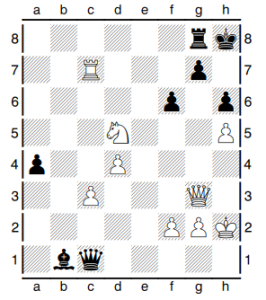
Ding Liren
39.Ra7!Not 39.Qf4?? Qxf4+ 40.Nxf4 Ra8!–+ when Black wins!
39…a3 40.Ne7! …Rf8
Ian Nepomniachtchi
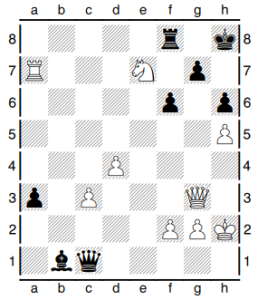
Ding Liren
41.d5!!
An extremely important preparatory move in weaving an unexpected mating net against Black King.
41…a2 42.Qc7! Threatening Ng6ch! and Qxg7 mate.
42…Kh7
42…Qg5 fails to 43.Ng6+! anyway, 43…. Bxg6 44.Qxg7#
43.Ng6! Rg8 44.Qf7!
The final position
Ian Nepomniachtchi
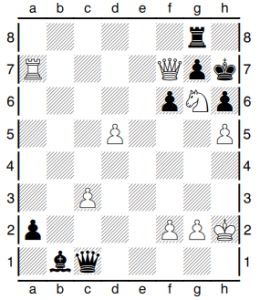
Ding Liren
Black resigned as there is no defence against Checkmate. for example,
44…. Qxc3
(Or if 44…Bxg6 then 45.hxg6+ Kh8 46.Qxg8+! Kxg8 47.Ra8#)
45.Qxg8+! Kxg8 46.Ra8+ Kf7 47.Rf8#
The White Pawn on ‘d5’ has played an important role in trapping the Black King.1–0




